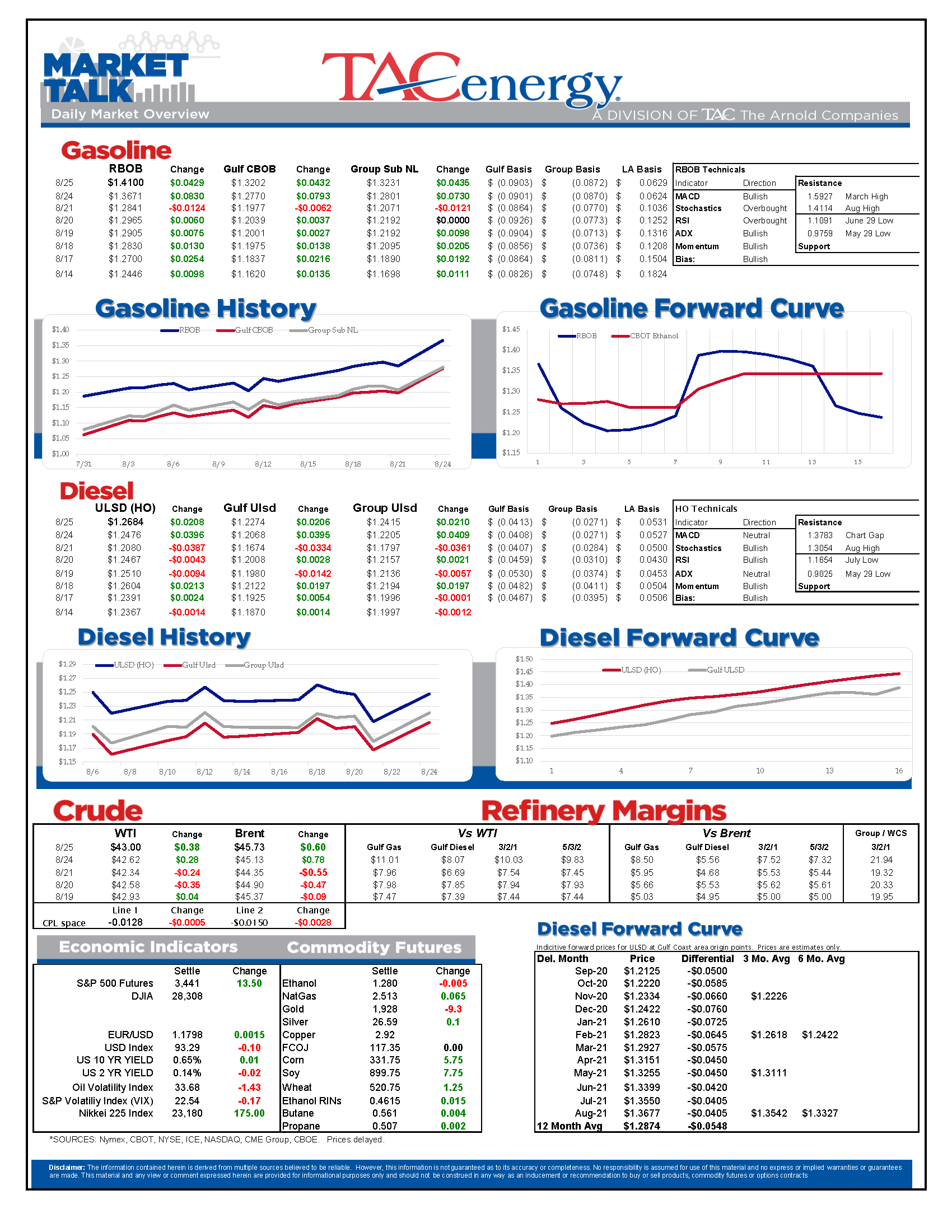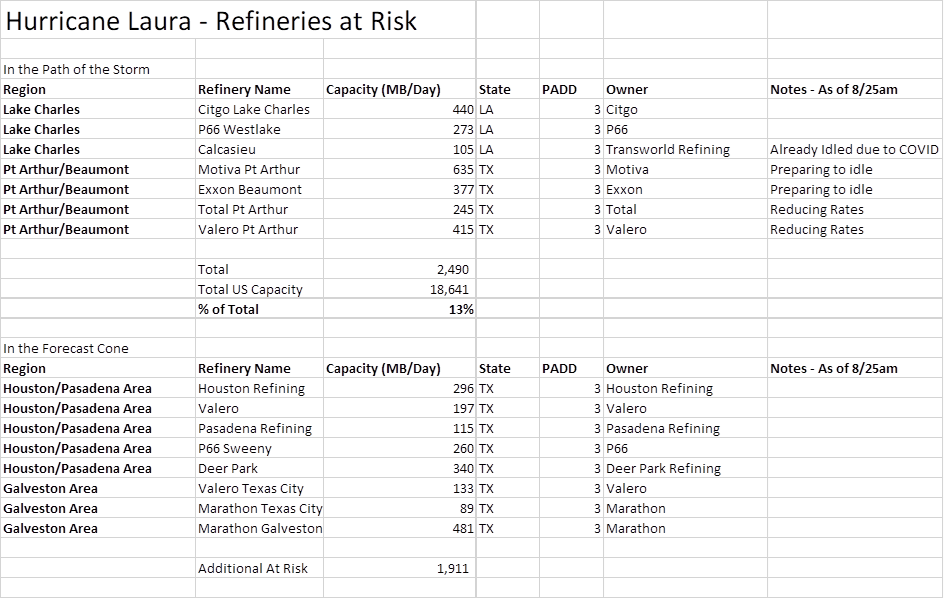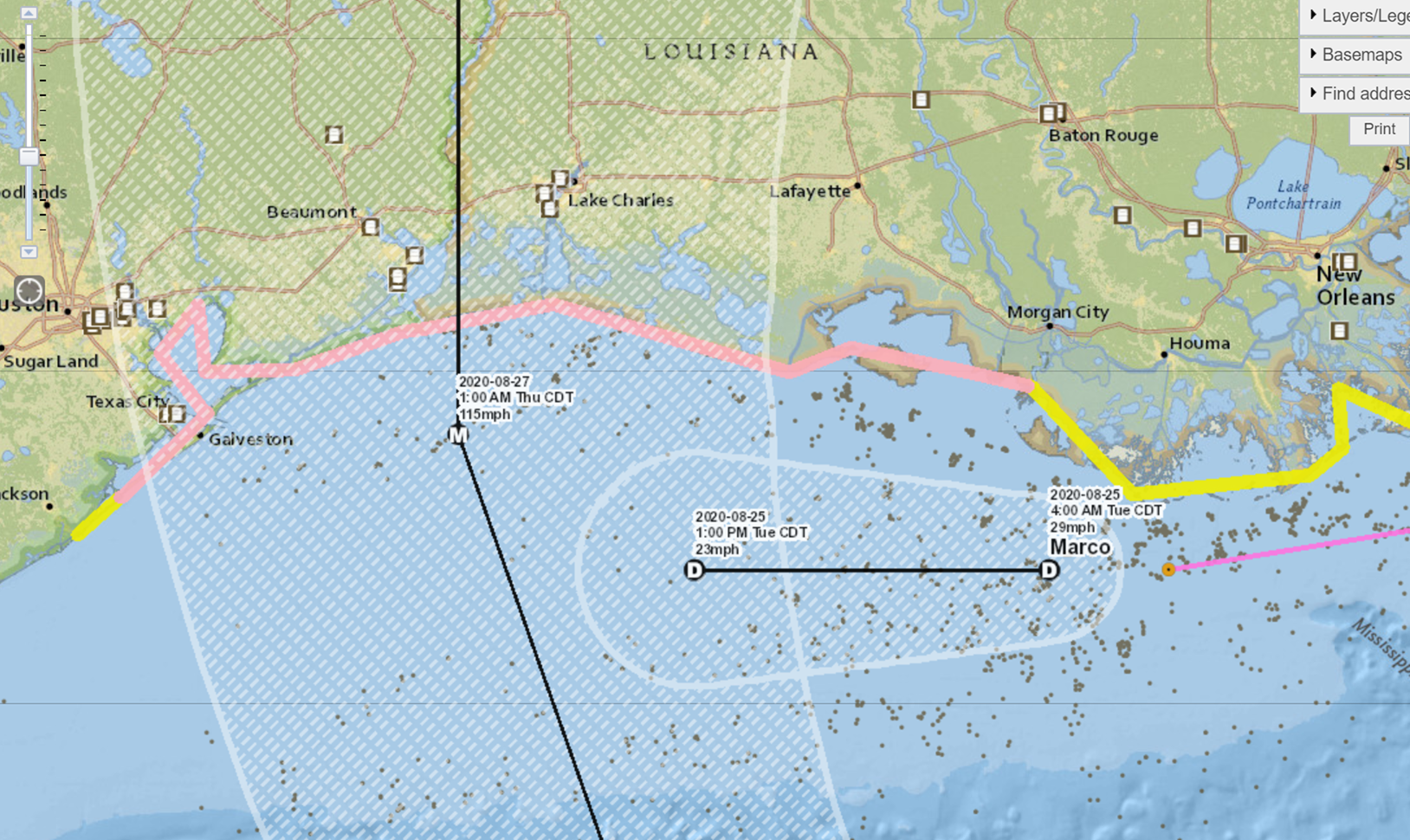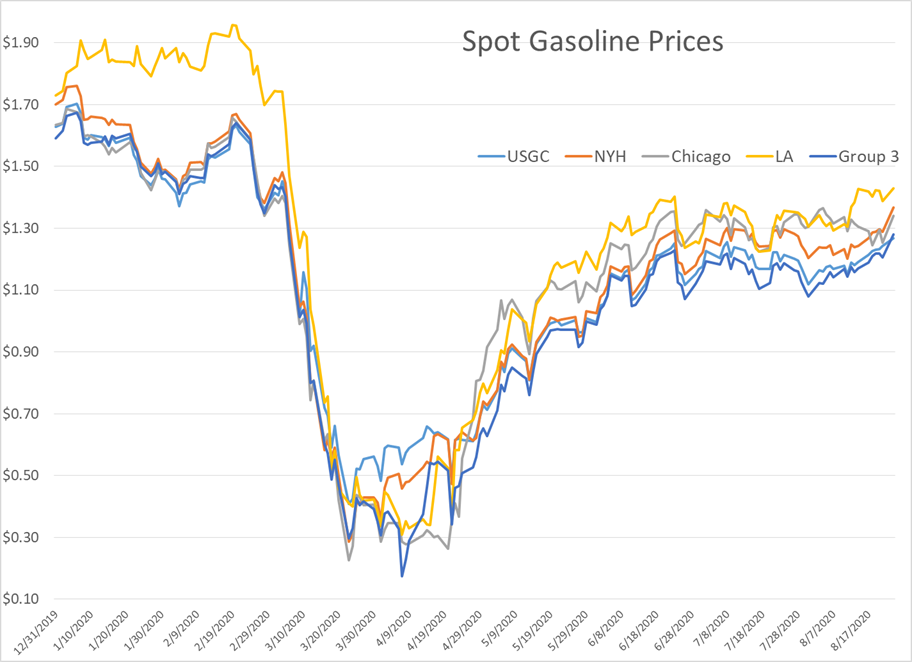Hurricane Laura Threatens U.S. Refineries

Gasoline prices are approaching six-month-highs as Hurricane Laura poses the biggest threat to U.S. refineries since Hurricane Harvey three years ago. Oil and diesel prices are moving higher as well, but are not keeping pace with gasoline – which is often the case in storm situations – and seem somewhat dubious about the long term impact this storm may have on an oversupplied market.
The Nasdaq and S&P 500 reached new record highs as trade and virus optimism kept the trend lines pointing higher, while the DJIA is undergoing a major overhaul. In the latest sign of the COVID market fallout, ExxonMobil is being removed from the DJIA, while Salesforce (dot com) will now be included.
While Marco fizzled out and spared Louisiana, Laura was upgraded to a Hurricane this morning, and 13 percent of the country’s refining capacity is in the direct path of the storm based on the latest models. The current forecasts have the storm coming on shore Thursday morning, as a category 3 “major” hurricane, just east of Port Arthur, TX. Plants in the Port Arthur/Beaumont hub have announced that they are reducing rates and/or idling units until the storm passes. The path of the storm could actually be just as troublesome, if not more, for plants around Lake Charles, LA, as they are on the more dangerous side of the storm, and could get a worse surge/flooding than the plants closer but on the west side. There is still a wide cone of uncertainty with this storm’s path, and even the Houston-area plants could still be impacted if the storm shifts further west.
Those plants that can continue operating are suddenly seeing their best margins in five months, a much needed relief for plants struggling to stay afloat financially. The economic hardship of refineries is one reason Laura’s impacts may not be as widespread as we might normally expect, since there’s at least one million barrels/day of capacity already idled due to weak demand, which should allow for some plants to increase rates and help offset the losses from others. In addition, many Gulf Coast refineries now rely on exports for nearly 20 percent of their production, so they will need to bring more product inland until ports can reopen.
That said, if the major pipelines in the region have to close due to power or flooding issues, then the potential for supply issues becomes more widespread in short order.
If Laura does make a significant impact, don’t be surprised to see states and the EPA ease RVP restrictions on gasoline, since we’re just weeks away from the annual transition anyway and pollution levels have already been at their lowest level in decades thanks to reduced consumption this year. You may notice that several spot markets aren’t keeping pace with the September futures contract this week, as they’ve already begun their fall transition to less-stringent gasoline specs.
Click here to download a PDF of today's TACenergy Market Talk.
Latest Posts
Week 16 - US DOE Inventory Recap
Energy Markets Trading Quietly In The Red As Ethanol Prices Rally To Five-Month High
The Struggle For Renewable Producers Continues As A Rapid Influx Of Supply And Crashing Credit Prices Make Biodiesel
After Years Of Backwardation, Diesel Prices Have Slipped Into Contango Over The Past Week
Social Media
News & Views
View All
Week 16 - US DOE Inventory Recap

Energy Markets Trading Quietly In The Red As Ethanol Prices Rally To Five-Month High
Energy markets are trading quietly in the red to start Wednesday’s session after a healthy bounce Tuesday afternoon suggested the Israel-Iran-linked liquidation had finally run its course.
There are reports of more Ukrainian strikes on Russian energy assets overnight, but the sources are sketchy so far, and the market doesn’t seem to be reacting as if this is legitimate news.
Ethanol prices have rallied to a 5-month high this week as corn and other grain prices have rallied after the latest crop progress update highlighted risks to farmers this year, lower grain export expectations from Ukraine, and the approval of E15 blends this summer despite the fact it pollutes more. The rally in grain and renewables prices has also helped RIN values find a bid after it looked like they were about to test their 4-year lows last week.
The API reported small changes in refined product inventories last week, with gasoline stocks down about 600,000, while distillates were up 724,000. Crude oil inventories increased by 3.2 million barrels according to the industry-group estimates. The DOE’s weekly report is due out at its normal time this morning.
Total reported another upset at its Port Arthur refinery that’s been a frequent flier on the TCEQ alerts since the January deep freeze knocked it offline and damaged multiple operating units. This latest upset seems minor as the un-named unit impacted was returned to normal operations in under an hour. Gulf Coast basis markets have shrugged off most reports of refinery upsets this year as the region remains well supplied, and it’s unlikely we’ll see any impact from this news.
California conversely reacted in a big way to reports of an upset at Chevron’s El Segundo refinery outside of LA, with CARBOB basis values jumping by more than a dime. Energy News Today continued to show its value by reporting the upset before the flaring notice was even reported to area regulators, proving once again it’s ahead of the curve on refinery-related events. Another industry news outlet meanwhile struggled just to remember where the country’s largest diesel seller is located.
Click here to download a PDF of today's TACenergy Market Talk

The Struggle For Renewable Producers Continues As A Rapid Influx Of Supply And Crashing Credit Prices Make Biodiesel
The sigh of relief selloff continues in energy markets Tuesday morning, with gasoline prices now down more than 20 cents in 7 sessions, while diesel prices have dropped 26 cents in the past 12. Crude oil prices are within a few pennies of reaching a 1 month low as a lack of headlines from the world’s hot spots allows some reflection into the state of the world’s spare capacity for both oil and refined products.
Gasoline prices are trading near a 6-week low this morning, but still need to fall about another nickel in order to break the weekly trendline that pushed prices steadily higher since December. If that trend breaks, it will be safer to say that we saw the end of the spring gasoline rally on April 12th for the 2nd year in a row. Last year RBOB futures peaked on April 12 at $2.8943 and bottomed out on May 4th at $2.2500. The high (at this point) for this year was set on April 12th at $2.8516, and the low overnight was $2.6454.
It’s not just energy commodities that are seeing an unwind of the “flight to safety” trade: Gold prices had their biggest selloff in 2 years Monday and continue to point lower today. Just how much money poured into commodities in the weeks leading up to the direct confrontation between Israel and Iran is unclear, but we have seen in year’s past that these unwind-events can create a snowball effect as traders can be forced to sell to cover their margin calls.
Supply > Demand: The EIA this morning highlighted the record setting demand for natural gas in the US last year, which was not nearly enough to offset the glut of supply that forced prices to a record low in February. A shortage of natural gas in Europe was a key driver of the chaotic markets that smashed just about every record in 2022, and an excess of natural gas supply in Europe and the US this year is acting as a buffer, particularly on diesel prices.
The struggle for renewable producers continues as a rapid influx of supply and crashing credit prices make Biodiesel, RD and SAF unprofitable for many. In addition to the plant closures announced in the past 6 months, Vertex Energy reported Monday it’s operating its Renewable Diesel facility in Mobile AL at just 50% of capacity in Q1. The truly scary part for many is that the $1/gallon Blender's tax credit ends this year and is being replaced by the “Clean” Fuel production credit that forces producers to prove their emissions reductions in order to qualify for an increased subsidy. It’s impossible to say at this point how much the net reduction will be for domestic producers, but importers will get nothing, and at current CI values, many biodiesel producers may see their “blend credit” cut by more than half.
Click here to download a PDF of today's TACenergy Market Talk.





